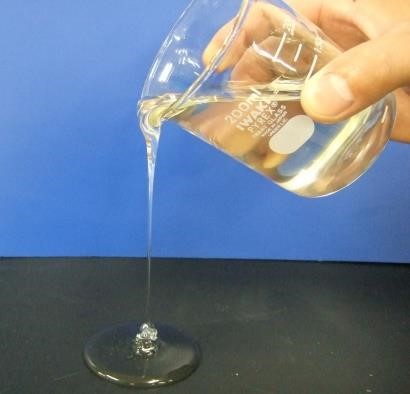Water leakage is a significant issue for builders to solve for prolonging the lifespan of a building and providing a comfortable place to live in. Some solutions to water leakage are gap sealing and painting, which are the usual finishing steps that prevent water penetration from the exterior through joints and gaps, specifically rainwater.
Over the years of research, scientists and manufacturers developed various types of sealant technology. The most common chemical sealants are silicone (SR), polyurethane (PU), polysulphide, and in a more recent development, hybrid technology polymers. Scientists are now focusing their efforts on Greener and better performance materials.
Kaneka has developed the latest hybrid polymer technology known as KANEKA MS POLYMER®. KANEKA MS POLYMER® has been growing exponentially for uses in the construction and automotive markets owing to Kaneka’s approach as a technical solution to the market needs. KANEKA MS POLYMER® is more appropriately known as a silyl terminated polyether (STPE), where a polyether chain is end-capped with reactive silyl groups giving a more controlled crosslinking. The etymology of the term “hybrid technology” comes from the fact that KANEKA MS POLYMER® is developed by combining the advantages of SR and PU while overcoming their shortcomings, making KANEKA MS POLYMER® an excellent choice of polymer as a sealant base.
MS sealant (KANEKA MS POLYMER® based sealant) is a moisture-cured system, similar to PU and SR sealants. At Kaneka, we produce a variety of KANEKA MS POLYMER® grades to meet different global standards in the construction and automotive industries. Our polymer grades are finely tuned by varying the polymer chain length and branching points to produce grades with various mechanical properties for multiple applications. Subsequently, KANEKA MS POLYMER® can be used for a wide range of interior and exterior applications, such as gap-filling sealants and high tack adhesives.
Unlike PU and SR sealants, MS sealant provides the solution to various sealant problems such as, UV resistance, paint compatibility, staining and dirt streaking problems. MS sealant brings both the advantages of PU and SR sealants together for a more versatile and greener material. KANEKA MS POLYMER® is the future of construction sealants and adhesives that gives longevity to buildings.
The main feature of MS sealant compared to PU sealants is that MS sealant eliminates the need for isocyanate compounds as raw materials, which are toxic to human beings. In addition, the solvent used in PU sealants also contributes to their high volatile organic compound (VOC). PU sealants curing reaction produces carbon dioxide as a by-product. Carbon dioxide released during curing occasionally causes PU sealants to form hollow cavities (air bubbles) in the sealant body after curing. These cavities reduce the tensile properties of PU sealant. Meanwhile, MS sealant does not contain both isocyanate and solvent, thus regarded as Green material.

Comparison of MS vs PU sealants (Bubbling occurs in PU)
MS sealant also has better UV resistance when compared to PU sealants due to MS’s pure polyether backbone being less susceptible to degradation than the PU backbone, which is made up of urea and urethane linkages. This resistance gives MS sealant an advantage over PU sealants for more extended durability performance.
When compared to SR sealants, MS sealant has inferior UV resistance. However, MS sealant has more advantages than SR sealants. MS sealant eliminates the use of silicone oil that can cause stain issues. Silicone oil will attract dust and cause staining, which eventually flows down and cause a reduction in building aesthetics. This phenomenon is sometimes known as dirt streaking, a significant drawback for most SR sealants.
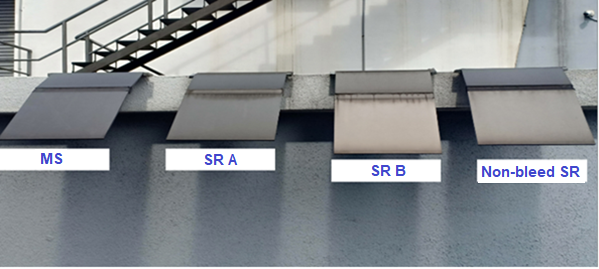
Dirt streaking test comparison of MS sealant vs SR sealants (Kaneka’s internal outdoor exposure test)
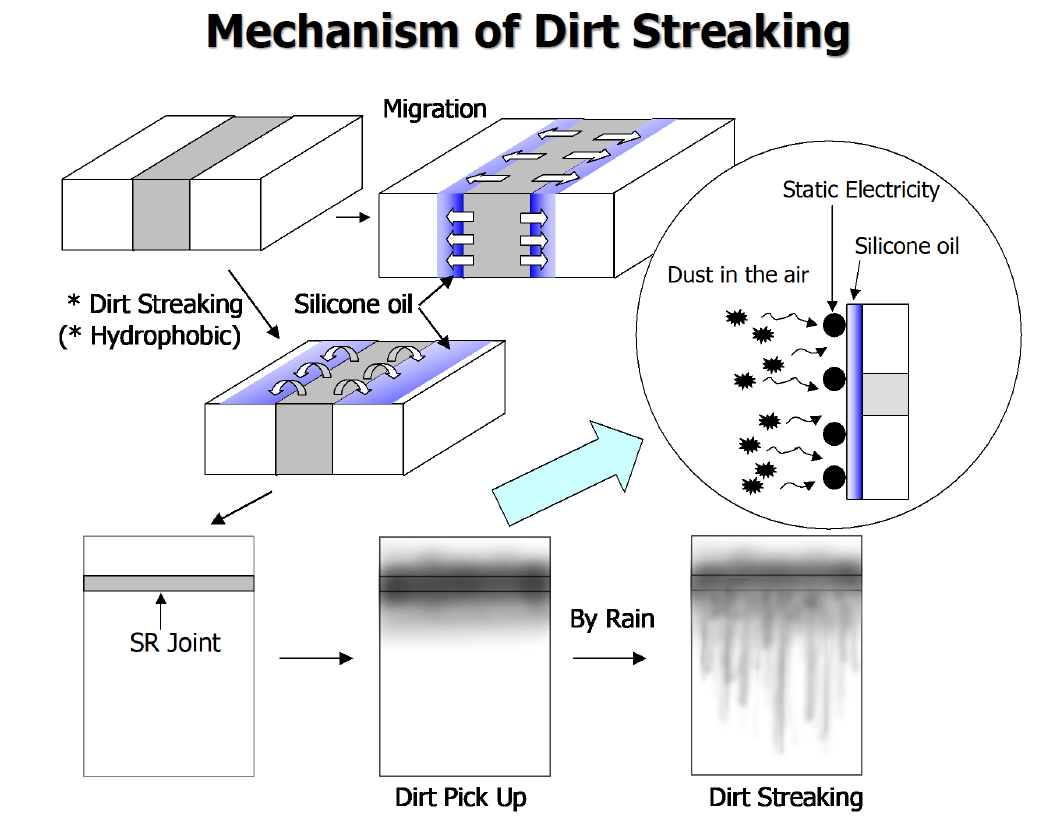
Mechanism of dirt streaking by silicone oil in SR sealants
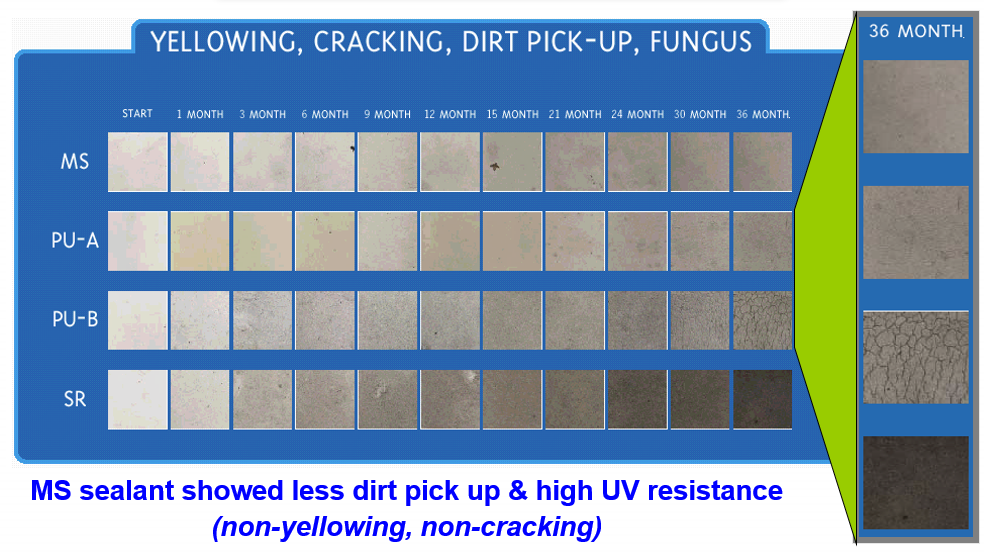
Comparison of durability between MS, PU and SR sealants
Another advantage of MS sealants over SR sealants is that MS sealants can be painted over with water-based paints and coatings. In contrast, SR sealants lack this feature due to the hydrophobic silicone oil, deterring the painting with water-based paints. MS sealant does not contain hydrophobic silicone oil, so that it can be painted over with water-based paints. This gives the advantage to MS sealant over SR sealants in exterior applications such as precast gap sealant and window perimeter sealant application, where paint over is needed.
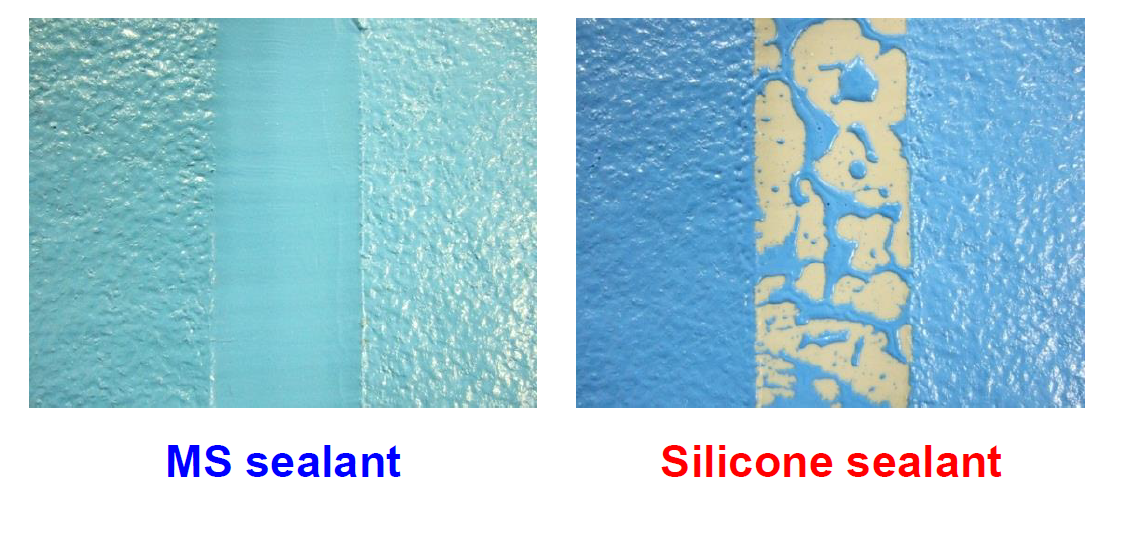
KANEKA MS POLYMER® resin
MS sealant is balanced and fares better than PU and SR sealants in terms of adhesion. Except for some thermoplastics such as PE, PP and Polystyrene, MS sealant can bond various substrates without primer. A comparison of adhesion over different substrates are shown below:
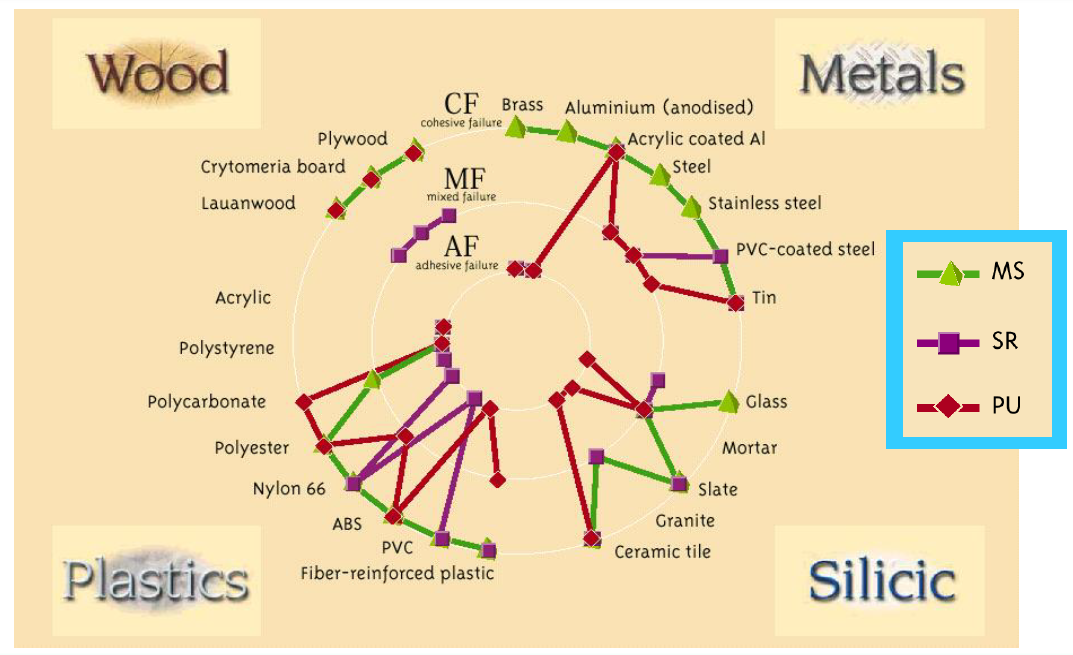
Adhesion comparison between MS, PU, and SR sealants
A quick summary of the advantages of MS over PU and SR can be found in the table below*:
Comparison between MS, PU, and SR sealants(1)
| Property | MS Polymer | Polyurethane | Silicone |
| Environmental friendliness | 10 | 5 | 9 |
| Non-bubbling | 10 | 6 | 10 |
| Low temperature extrudability | 10 | 8 | 10 |
| Slump resistance | 10 | 10 | 10 |
| Quick cure | 10 | 7 | 10 |
| Storage stability | 10 | 7 | 9 |
| Body (tooling) | 8 | 10 | 8 |
| Weather resistance | 8 | 6 | 10 |
| Adhesion to various substrates | 10 | 5 | 8 |
| Mechanical properties | 10 | 10 | 10 |
| Heat resistance, mechanical stability | 9 | 8 | 10 |
| Non-dirt pickup | 10 | 10 | 5 |
| Stain resistance | 8 | 8 | 5 |
| Paintability with water-based paint | 10 | 10 | 3 |
Scale: 10=excellent; 1=very poor
Regardless of the requirement of the target applications, KANEKA MS POLYMER® is a versatile material with a wide range of polymer grades that provide endless possibilities for finished products for a greener and cleaner future.
To find out more about Kaneka and performance polymer products, please contact:
KANEKA MALAYSIA SDN BHD
Website: www.kaneka.com.my
Email: [email protected]
Source:
- Petrie, Edward M. 2010. “MS Polymers in “Hybrid” Sealants.” (The Adhesive and Sealant Council, Inc.). https://www.adhesives.org/docs/default-document-library/hybrid_sealants_may2010-final-(1).pdf%E2%80%8B.
- *Hashimoto, K., “Silyl-Terminated Polyethers for Sealant Use: Performance Updates”, Adhesives Age, August 1998.



